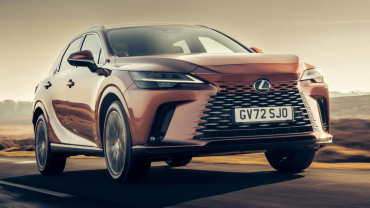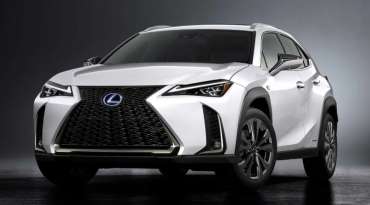Displaying items by tag: Lexus RX
New Lexus RX 450h+ 2023 review
Lexus's large SUV offers plenty of luxury and tech, but it's not as family-friendly as its size would suggest
Verdict
The new Lexus RX 450h+ delivers on plenty of traditional Lexus attributes. There’s an impressive array of technology on board, the ride is tuned for comfort above all else and the build quality is exemplary. It’s a big SUV so fairly average practicality might be its undoing for some families and keen drivers will be better served elsewhere.
The Lexus RX was one of the first to secure a slice of the burgeoning luxury SUV sector when it launched in the late 1990s and the model line has gone on to reach 3.5million sales globally, helped by its pioneering hybrid technology.

Within the Lexus stable, the RX has been arguably the most successful car at taking on the established players from Germany. The incorporation of a self-charging hybrid powertrain in 2005 was a defining moment for the RX, but since then it’s taken evolutionary steps with a clear focus maintained on comfort and build quality. With this fifth-generation RX, however, Lexus claims it has made “a complete reinvention of the large luxury SUV” and produced a large premium SUV that is more competitive than ever.
The new RX has arrived just at the right time. 2023 has seen both the Mercedes GLE and BMW X5 receive mid-life updates, with hybridisation being added across the range for both models. As an early adopter of hybrid power, it’s no surprise every Lexus RX is electrified.
The entry-level 350h comes with a 247bhp 2.5-litre four-cylinder petrol with self-charging hybrid technology and there’s also a 500h “performance hybrid” with 366bhp from its turbocharged 2.4-litre and plug-in hybrid system - the first time Lexus has mated turbocharging with hybrid power.
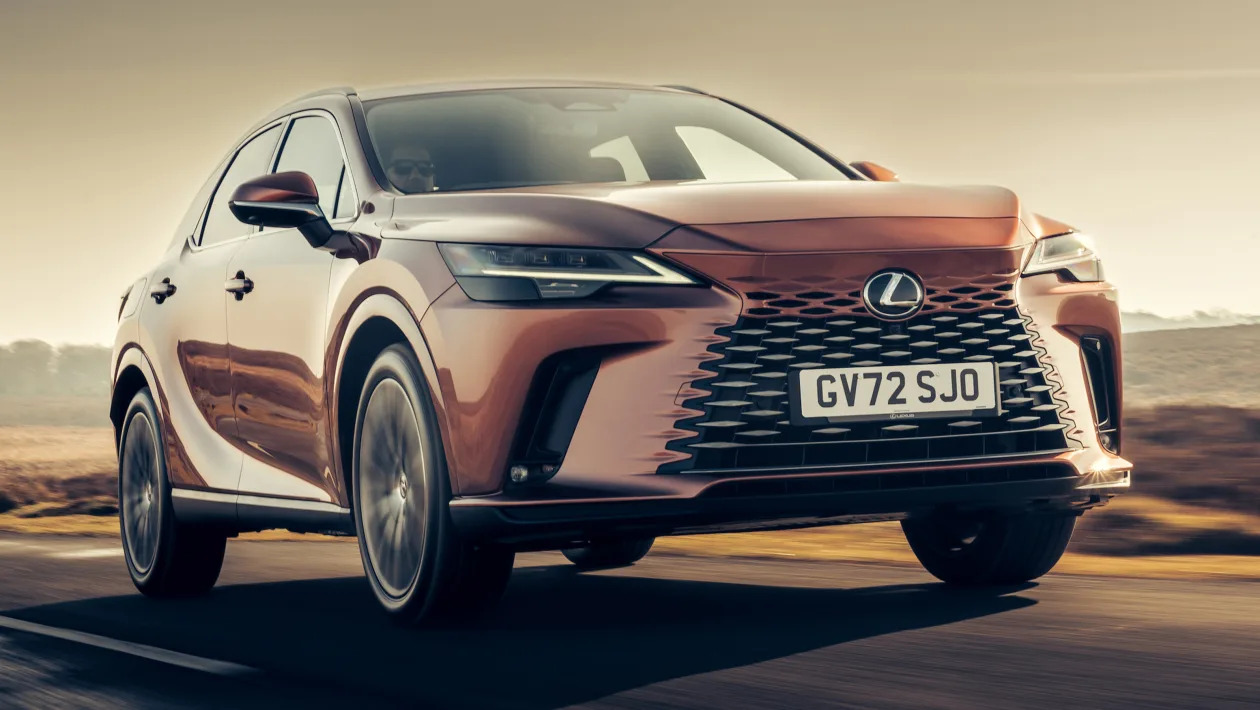
In the middle of the pack sits the 450h+, which borrows its 2.5-litre four-cylinder petrol engine and plug-in hybrid system from the new NX - the first Lexus to offer PHEV capability. The new all-electric RZ (Lexus’s first bespoke full-EV) might look similar to the RX, but that car will use the e-TNGA platform found under the Toyota bZ4X and Subaru Solterra. The RX actually sits on the same GA-K platform as the smaller NX.
Our first taste of the new RX comes in 450h+ form - which Lexus says will account for 55 per cent of sales for its large SUV. The petrol engine combines with a 18.1kWh battery and an electric motor to drive the front wheels but there’s a second electric motor on the rear axle delivering electric four-wheel drive in certain circumstances. On paper the 450h+ sounds potent enough with 304bhp allowing for a 6.5-second 0-62mph time.
It takes a little time to adapt to this powertrain and ensure you’re playing to its strengths. It uses an e-CVT gearbox so if you’re mashing the throttle for an overtake, the petrol engine’s revs will rise to a rather unrefined drone. Hard acceleration overall feels a little underwhelming in the 450h+ although the system is perfectly smooth in its power delivery. Strangely, there are gearshift paddles behind the wheel which display the CVT’s ‘gears’. Given that there’s only one variable gear available in a CVT, moving up and down the simulated steps yourself doesn’t really have much of an effect on the driving experience. You just alter the level of engine braking slightly by raising or lowering the revs, we expect 99 per cent of RX owners won’t ever use the paddles.
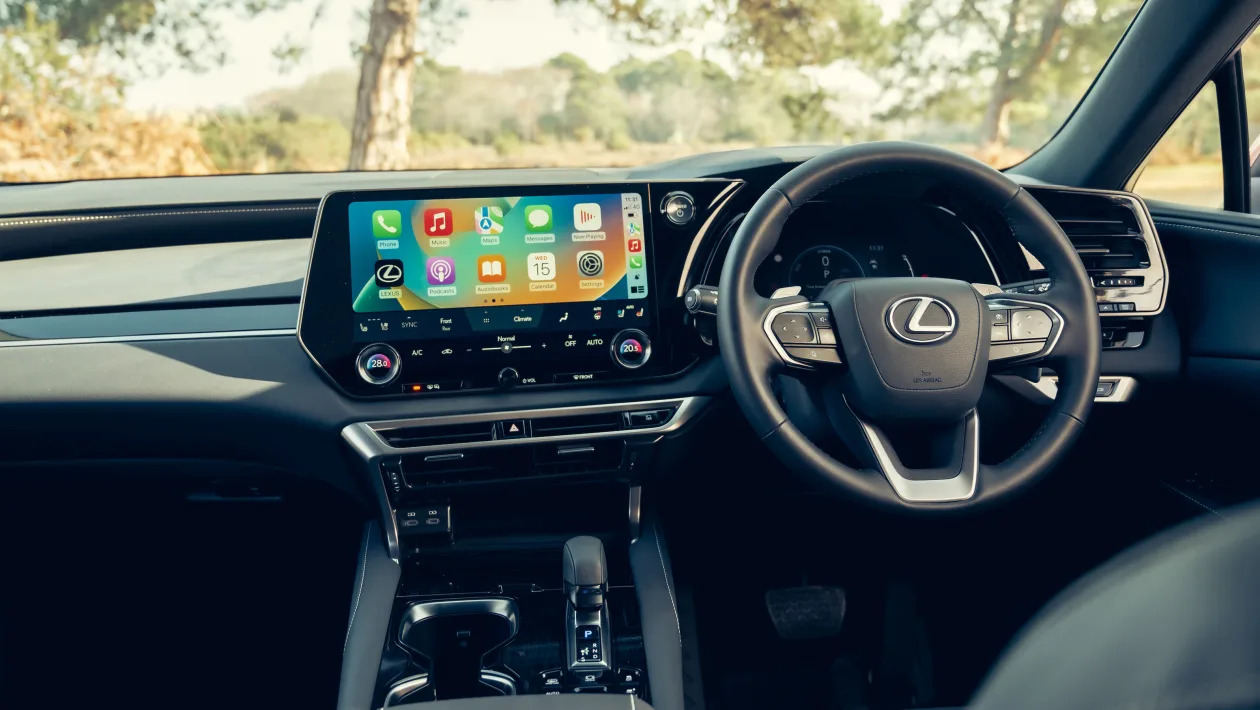
Provided you have enough energy in the battery, you can, of course, switch to electric only mode. The instantaneous torque gives the RX some extra pep around town and silent EV running certainly suits the RX’s calm persona. Lexus claims around 40 miles of electric-only running is possible - most people should get near to this figure with careful driving.
Once that 18.1kWh battery has been emptied (the 6.6kW on-board charger means a full charge takes around two hours and 45 minutes), there’s a second battery that allows the 450h+ to run as a self-charging hybrid. This essentially means you’re always utilising the efficiency benefits of hybrid running. It’s the first time we’ve come across this technology and for PHEV users that might forget to charge or find it impractical to do so regularly, it’s a nice safety net to have. Even with this innovation, the claimed 256.8mpg WLTP fuel economy figure will probably be out of reach for normal driving.
The powertrain rewards relaxed driving and this statement applies to the suspension too. Our car was fitted with adaptive damping, which doesn’t vary too much depending on your chosen setting. Even with 21-inch alloy wheels, it's plainly obvious the RX has been engineered to float over bumps and dips, rather than communicate the road surface to the driver.
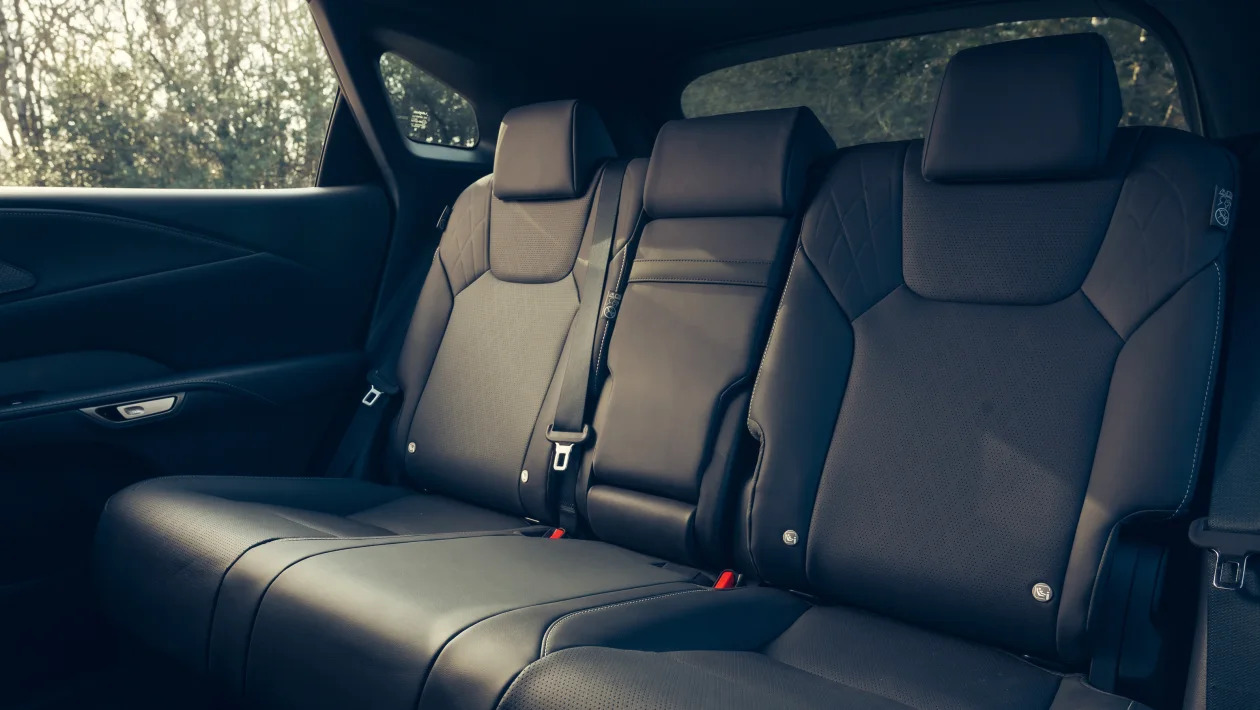
We’re keen to try out the ‘Direct4’ four-wheel drive system exclusively offered on the RX 500h, which apparently keeps pitching under acceleration and braking at bay - that rocking motion was especially prevalent on this 450h+.
Arrive at a series of bends and despite the focus on comfort, the RX can get into a rhythm. The steering wheel has a reassuring weight to it and the handling is tightened by the availability of six degrees of rear-axle steering. You’re always aware of the 2,240kg kerb weight but you can still flow the RX into corners nicely. Get a little too abrupt with steering inputs and you’ll a tendency towards safe, nose-heavy understeer.
Lexus says it has worked hard on improving the RX’s refinement, although the previous model was one of the best in its class in this respect. The powertrain certainly helps, but thicker glass and more sound proofing means this model is supremely quiet even at motorway speeds.
The interior compliments the sedate nature of the RX very well. We tested the top-spec Takumi trim level, which has a huge electric panoramic roof, heated seats front and rear, three-zone climate control and an uprated sound system.
The 14-inch central screen is the main focal point up front and the infotainment system responds immediately to inputs, either from the touchscreen itself or from the steering wheel buttons. It marks a huge step forward from the old track pad setup from the previous Lexus RX and Apple CarPlay or Android Auto can be wirelessly connected as well.
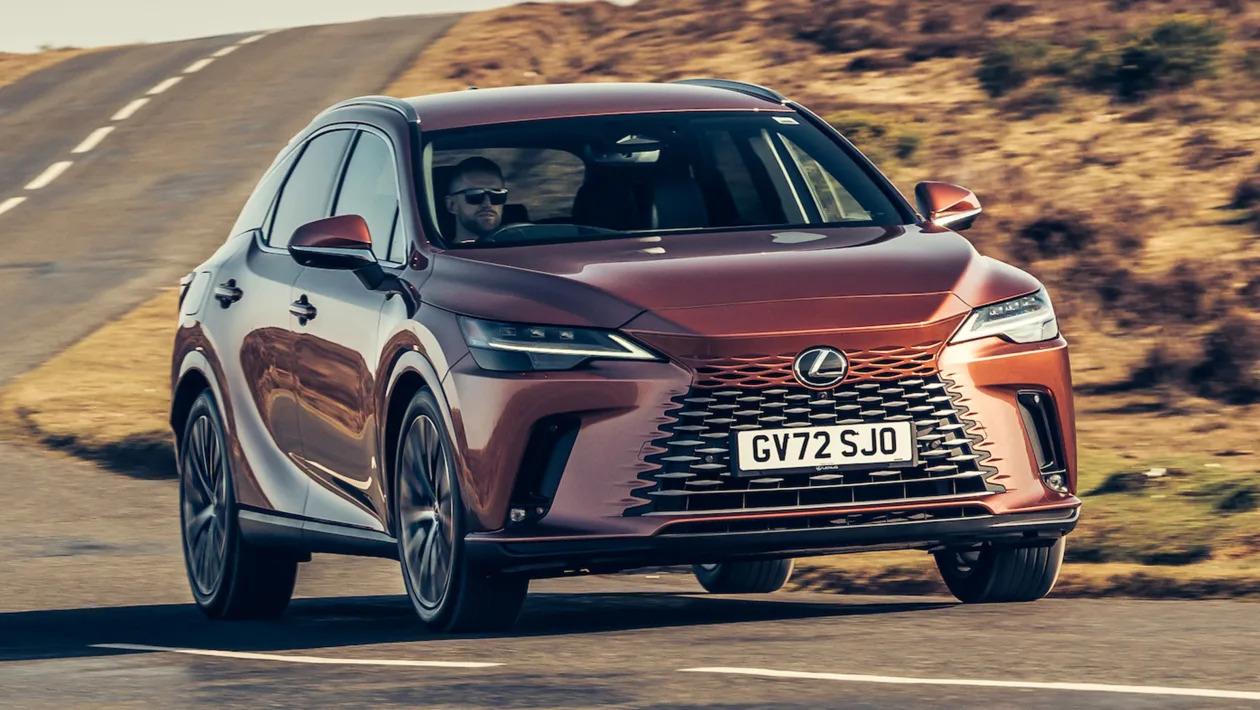
A Mercedes GLE might have the RX beaten in terms of interior wow factor, but the Lexus is up there with the very best for build quality. All the main touchpoints feel solid and things like the door handles and centre console openings are superbly damped. The rear seats can be folded up and down with the touch of a button - parents might prefer the quicker manual lever on lower-spec models.
There are lots of little cubby holes dotted around the cabin and the rear seats will accommodate three adults with no problem, but the lack of a seven-seat model is a bit of a shame. The 461-litre boot is also a little disappointing compared to the competition.
A mid-range ‘Premium Plus Pack’ still offers the panoramic roof as well as a head-up display and wireless charger. It also has the adjustable digital rear view mirror/monitor, which is an impressive bit of kit but slightly superfluous considering rear visibility is perfectly acceptable.
The RX with this 450h+ powertrain kicks off at £64,950 in Premium Plus guise - rising to £79,450 for this Takumi model. Given the new 2023 X5 starts from £66,230 with a mild-hybrid engine and you can’t get a Mercedes GLE for under £77,890, the RX 450h+ appears to be keenly priced.
New Lexus RX 450h+ 2022 review
The new Lexus RX aims to bring the brand’s latest technology to bear on the full-size premium SUV market
Verdict
The new Lexus RX takes known tech from the smaller NX and extrapolates this into a bigger package. There's much to like here. The new infotainment and the efficiency potential from the 450h+ powertrain are huge steps forward, while the Lexus rides and handles fairly well. However, it doesn't fulfil its brief quite as well as its smaller sibling. In this large premium SUV class the Lexus is facing some very luxurious competition, such as the BMW X5 xDrive45e, and we'd like a little more refinement as a result. Pricing will also be key to the success of the package.
For years Lexus has tried and not necessarily always succeeded in taking on established premium players – mostly from Germany – but more recently it's hit a rich vein of form.
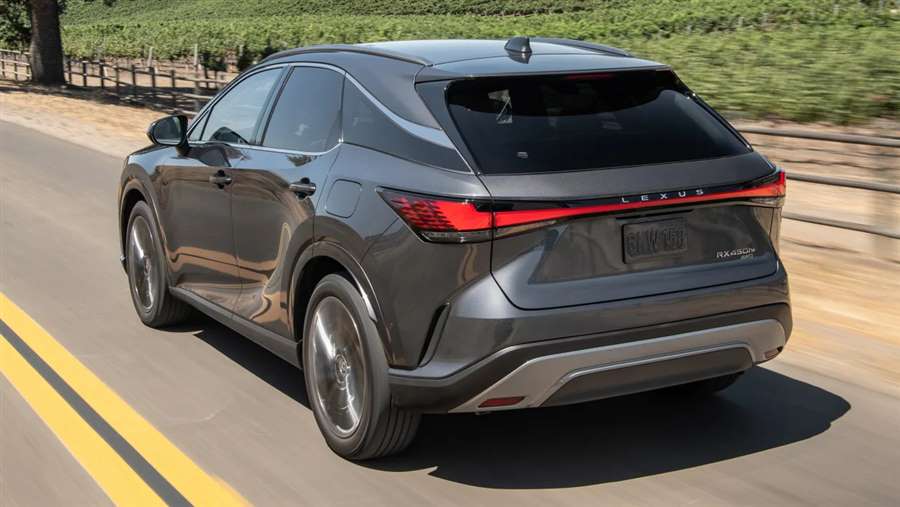
Thanks to an all-new platform and, in something of a first from Lexus, a plug-in hybrid powertrain, the brand's latest NX mid-size premium SUV boasts a brilliant all-round blend of qualities in this most competitive of classes. And now Lexus is aiming to scale up that formula for its all-new RX.
Whereas the NX rivals cars such as the BMW X3 and Mercedes GLC, the RX is a BMW X5 and Mercedes GLE competitor. But like its smaller sibling, this fifth-generation RX is also based on the brand new GA-K platform and features Lexus's 450h+ powertrain, making it the first-ever plug-in hybrid RX. In fact, Lexus claims “it's a complete reinvention of the large luxury SUV”.
That's quite a statement - as is the new car's styling, which is the first thing you might notice. Along with the NX and forthcoming RZ all-electric SUV, this RX will define the Japanese brand's next chapter in terms of design.
We've seen the firm's 'spindle grille' front-end before, but the RX evolves that into what Lexus is calling 'spindle body'. The grille is bigger with the overall shape now integrated into the whole front end of the car's body.
There are slim headlights, sharp creases down the sides and a rakish 'floating' roof thanks to blacked-out C-pillars, plus a full-width light bar across the raked tailgate. It's clearly an evolution in design terms, but still recognisably a Lexus.
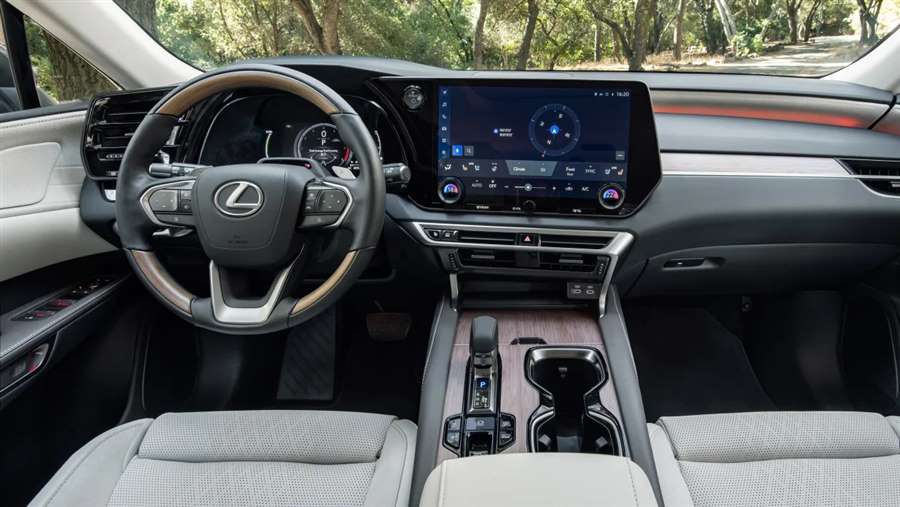
The same is true inside. The brand is making a much bigger feature of its Japanese heritage these days, and we're all for it. The cabin takes a 'less is more' approach, with the 14-inch central touchscreen dominating the layout.
Lexus's latest infotainment system is a massive improvement on the old track pad-based setup in the previous RX, too. It works snappily, offers plenty of features and now integrates Apple CarPlay and Android Auto, both wirelessly.
Our top-spec Takumi model also featured adaptive suspension, heated and vented leather seats, three-zone air-conditioning, a panoramic roof, 21-inch alloy wheels, a head-up display, LED headlights and wireless phone charging as standard.
In typical Lexus fashion, the cabin feels beautifully built and material quality is good, but there's not much in the way of flair to the design, which could be an issue at this level of the market. On that point, prices will be announced later this year, but expect the base RX 350h self-charging hybrid to start from around £60,000 when it goes on sale later in 2023.
It's the new 450h+ plug-in hybrid we're focusing on here, however. It uses a 2.5-litre four-cylinder petrol engine working in conjunction with an 18.1kWh battery that feeds an electric motor driving the front wheels and another unit located on the car's rear axle to deliver e-four-wheel drive. The total output stands at 304bhp with the 0-62mph sprint dispatched in 6.5 seconds.
Performance is absolutely fine. It doesn't ever feel rapid, but in electric mode there's enough grunt. Lexus claims a zero-emissions range of more than 40 miles, which seemed accurate and achievable to us on the launch.
When the 18.1kWh battery is depleted (the 6.6kW on-board charger means a full charge takes around two hours and 45 minutes), the RX uses its second battery and becomes a self-charging hybrid, like the 350h powertrain; it's a technological first as far as we're aware and means that even when you've used the bigger battery's energy, there's still strong efficiency potential. Official economy claims stand at up to 256.8mpg with CO2 emissions and a Benefit-in-Kind taxation banding as low as 24g/km and eight per cent respectively.

Once energy is depleted, or the petrol engine kicks in, refinement takes a hit as even with the improvements Lexus has made when it comes to the operation of its e-CVT automatic gearbox, the petrol motor still drones – especially if you ask for hard acceleration.
The trick is to drive to the powertrain's strengths and lean on the electricity. Then the engine isn't as noticeable and the RX delivers a relaxed drive.
Like with the NX, there's more linearity to the way the powertrain responds and the petrol engine revs up. This gives a better connection between car and driver, and while it's still not perfect, in a big SUV like this it prioritises comfort and easy-going dynamics over sportiness.
The new platform means the RX still acquits itself relatively well, however. Our test route in the US didn't provide much in the way of challenging corners or surfaces, but the RX rides relatively nicely, with the damping control and comfort only breaking down over the worst transverse bumps and ridges in the road, where the extra battery mass becomes apparent. Otherwise, the suspension works smoothly to filter out imperfections and control the body.
The steering is light, but this helps manoeuvrability, as does the rear-axle steering, which offers up to four degrees of lock on the back wheels. However, the RX doesn't feel like a big car. It doesn't feel like a particularly dynamic one either, but there's enough agility here by the same stroke.
In short, it delivers a decent balance between comfort and engagement, with the focus placed on the former, meaning the RX is a solid SUV from a driving perspective, given how it will be used most of the time.
The 461-litre boot is some way off the biggest cars in this class, however – and this is despite the lithium-ion battery being mounted under the car's floor to help packaging. While there's enough space for most duties, a family holiday could test the RX's load-lugging capability more than a BMW X5 xDrive45e, for example.
However, space in the rear is better with enough head and legroom (even if rivals still feel roomier), while electrically adjustable heated seats in the back are standard on top-spec Takumi models, which is a nice touch.
Source: autoexpress.com
2022 Lexus RX Redesign
The 2022 Lexus RX Redesign is a solid entry in the midsize SUV class, offering a roomy and comfortable cabin and typically excellent build quality, as well. We have been let down by this generation's anonymous driving experience and poorly thought-out infotainment system controller, too. The improvements it made to this year's RX will rectify these shortcomings, Lexus hopes.
It retuned the suspension and stiffened the body structure to give the RX a slightly sportier feel when driven around turns while still keeping ride comfort paramount, Lexus says. Has been modified as well, the F Sport's sport suspension, which previously resulted in a far harsher ride in exchange for minimal performance gains.
Lexus has swapped out the mouse-like controller for a new trackpad, inside the cabin. Can still be overly distracting to use while driving, but it's better. The display screen is new also. Meaning you can avoid using the trackpad by touching the various menus and buttons, it's now a touchscreen. Repositioned the screen to be nearly 6 inches closer to the driver, so reaching the screen doesn't require a stretch, Lexus also. Apple CarPlay and Android Auto are also on board this year as standard equipment, finally. To improving the RX 350's tech cred, these changes go a long way toward.
With drastic quality-of-life improvements that make it a more appealing buy than last year's model, the 2022 Lexus RX Redesign is more competitive than ever. Before an also-ran in the midsize luxury crossover segment, the RX has graduated to become a respectable offering in the class, as well.
Which RX 350 does we recommend?
We prefer the F Sport's more aggressive yet still comfortable sport seats, the base Lexus RX Redesign 350 is more well-rounded and appeals to a broader set of buyers. Because it adds the sharp-looking 12.3-inch display, an upgraded audio system, and onboard navigation for when your adventures take you to locales with spotty cellular service, so the Navigation package is worth getting.
Lexus RX Redesign 350 models
Is available in base and F Sport versions, the 2022 Lexus RX Redesign 350. So, they both come with a 3.5-liter V6 engine (295 horsepower, 267 lb-ft of torque) paired to an eight-speed automatic transmission, too. All-wheel drive is optional and front-wheel drive is standard.
Than, the base is equipped with features such as a power liftgate, dual-zone automatic climate control, simulated leather upholstery, adaptive cruise control, a suite of driver safety aids (Lexus' Safety System+ 2.0), an 8-inch touchscreen, and a nine-speaker sound system, as well. Also standard this year is Apple CarPlay and Android Auto integration.
Premium and Luxury, a couple of packages, are available to boost up the RX's features list, too. A sunroof, bigger wheels, heated and ventilated front seats, and leather upholstery, notable additions from them include. The F Sport includes the Premium package's contents plus sportier exterior styling, a sport-tuned suspension, sport front seats, and unique interior. Than, the optional F Sport Performance package adds adaptive suspension dampers and specially tuned steering. Lexus offers a Navigation package, which gets you a navigation system, a larger 12.3-inch touchscreen, and either a 12-speaker sound system or an optional 15-speaker Mark Levinson system, for both versions. Than, other worthwhile options to consider are blind-spot monitoring, power-folding second-row seats and a hands-free liftgate, as well.

